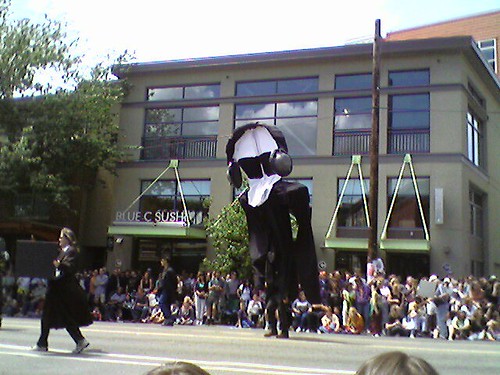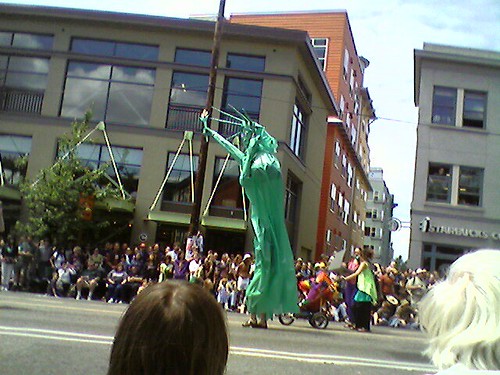Saturday, June 24, 2006
Review: Evil Aliens (SIFF 2006)
Evil Aliens is a camp-horror-comedy where some Welsh farmers, a UFO geek, and a camera crew face of with a bunch of scary-looking and aggressive aliens. The aliens are set out to conquer and abuse, and the humans are out to defend themselves (sometimes with bats, sometimes with tractors). Honestly, that's really all you need to know to decide whether you want to see this movie or not. Like a Junior High dance, I think you've now divided yourselves against two sides of the room: either hell-bent to see it, or very sure to avoid it.
The best part of Evil Aliens is its references to other horror/thriller and action movies, such as Aliens, Predator, and Evil Dead. Movie junkies will probably get the most fun out of trying to catch all of these reference while watching the gore fly.
Overall rating: 7.0 /10.0
Details:
Runtime: 93m
Country: United Kingdom
Language: English
Wednesday, June 21, 2006
Review: Blood Rain (SIFF 2006)
We quickly learn of a dark past on the island: a man was wrongly executed a long time ago, and now, the locals believe the spirit of this man is killing the informants who wrongly accused him. The investigator witnesses informant after informant dying a gruesome and unexplainable death, and is ever-pressed to figure out who or what is murdering these people.
Blood Rain takes a little while to start up, as you adjust to the period of the film and learn about the setting and the main characters (there are several, with similar-sounding Korean names to my Western ears). But once it does, it keeps your interest like any good murder-mystery does.
Along with the puzzle element of the movie, I enjoyed a glimpse into the societal pressures alternately guiding and forcing the investigator in his quest to solve the mystery, such as one's honor and "place" in society. I can't vouch for how accurate a depiction of 19th-century Korea Blood Rain really is, but the depiction of the characters and their role on this island was nevertheless a nice addition to the mystery element.
Overall rating: 7.5 /10.0
Details:
Runtime: 119m
Country: South Korea
Language: Korean
Tuesday, June 20, 2006
New Restaurant "Fork" Closing Its Doors
Very sad, but understandable. I hope Scott is able to return to his trade soon, in whatever capacity he can.
Sunday, June 18, 2006
Bad Usability: Brookstone Bedroom Clock
Enter the Brookstone 5-in-1 Sensor Clock. It's an attractive little clock/calendar/alarm/thermometer/timer that we've been using the past few days for its alarm feature. The front of the clock is all display and housing. The back of the clock offers the following:
- Mode Lock (on/off) - slider switch
- Sensor (on/off) - slider switch
- Mode - pushbutton
- Set - pushbutton
- Up arrow - pushbutton
- Down arrow - pushbutton
A "mode" is effectively one of the five features of the clock. The sensor allows you to switch modes by waving your hand over the device, as does the Mode button. The Set button, along with the up and down arrow buttons, allows you to set things like the time.
So, we flipped to the Alarm mode, pressed Set, set the hours, pressed Set, set the minutes, and finally pressed Set again. The alarm was set, and a little alarm clock icon appeared in the upper-left of the display to indicate that the alarm was enabled.
Now, after a few days, we noticed that the alarm was recurring each day at the preset time. Makes sense, especially given that the little alarm clock icon was still there. So, we set out to disable the alarm.
Now, the question: how do you do it?
We tried the following, all to no avail:
- Cycled through "Set" while in the Alarm mode
- Set the hours and the minutes again on the Alarm
- Pressed and held Set
- Pressed and held Set and Mode together
- Pressed the up arrow while in Alarm mode
- Pressed the down arrow while in Alarm mode
- Tried the above with the Mode switch and the Sensor switch set to both positions.
So, what's the answer? A quick flip to the manual for the clock revealed it. You have to press and hold the up arrow while in Alarm mode to enable the alarm, and press and hold the down arrow while in Alarm mode to disable the alarm. Setting the alarm automatically enables the alarm.
What's wrong with this picture? There was absolutely no UI, message, indicator, report, sound, warning, or other method of communicating this information to the user. And we're not talking lack of UI for an edge-case scenario here. Enabling and disabling the alarm is probably one of the most common operations for a little portable clock like this one. To solve the mystery, I had to access Brookstone's web site and browse the manual. If Brookstone didn't have the manual online, I would probably still be stuck.
How did this mistake slip through? In my opinion, I believe the designers here mistakenly assumed that people would read and memorize the manual, to remember this tidbit of information. In reality, most people throw away the manual, throw the clock in the luggage, and go on their way. I bet there's an army of little 5-in-1 Brookstone clocks out there that people are resetting by pulling the batteries out or by inserting a paper clip in the Reset switch, because of this mistake.
This clock served as a reminder to me for one of the most basic design tenets: stay firmly anchored to the users and scenarios you're designing for, and keep prototypes of your design in front of real users' eyes to get honest feedback.
Saturday, June 17, 2006
Fremont Fair 2006
Some pictures from the parade:

The Sisters of Perpetual Indulgence were out in full force today.

More than one papier-mache version of George W. Bush was on display.

Go, marching band!

The Brazilian band and dancers were quite good.

This was supposed to be about spying. Looks more like a large Scream-masked individual to me.

Statue of Liberty.

Dancing, feathered people.
Post-Dinner Cupcake Royale
As you can tell, they were busy tonight.

But, we scored a box nonetheless.

Yes, new camera phones are fun.
Sunday, June 11, 2006
Cheap Copper River Salmon At The Seattle Costco
To compare, I saw some filets at Whole Foods for sale last week at around $30 a pound. Ack!
Saturday, June 10, 2006
Review: Black Gold (SIFF 2006)
These are the questions Black Gold posits. While focused on the fair trade movement and its effects in a burgeoning Ethiopean coffee growers co-op, the theme resonates beyond coffee and forces you to question how and where the products we eat and buy come from, and how much the growers versus the middle men are earning for these products.
Black Gold reviews the efforts of Tadesse Meskela, the General Manager of the Oromo Coffee Farmers Co-operative Union. Tadesse's main focus is to remove the middle men between the coffee farmer and coffee roaster, and return more money to the farmer's pocket.
So, what's the problem with conventional coffee? In a sentence, the global price is set in commodities markets in New York and London, and no consideration is given to the local cost of living for a given farmer and his family. Currently, Ethiopian farmers get about $0.24 a kilo. A living wage for them would be about $2.00. That's still a very small price to pay to the grower given the cost of a pound of beans or an espresso drink here in the States, yet prices are kept low and farmers have to make do with a tenth of what they need. Furthermore, World Trade Organization talks in the past few years have failed to negotiate a fair price for coffee and other commodities for the Third World.
The result is that coffee, one of Ethiopia's most abundant natural resources, is sold for very little money. Farmers as a result don't have clean water, enough food, or good schools to send their children. Ironically, the film shows the amount of aid we give to countries like Ethiopia, and contrasts it with the little money we purchase their resources with. It also shows how a very small boost in the GDP of these countries would overshadow the amount of aid that we currently give them.
As a film, Black Gold is very well made. Excellent camerawork, editing, and a comfortable pace, combined with moving images of farmers and their families struggling to survive, make for a great documentary. Add to that the overall message and the information the documentary provides, and Black Gold becomes a movie most any Western consumer should watch.
Overall rating: 9.0 /10.0
Details:
Runtime: 82m
Country: United Kingdom
Language: English, Ethiopian, Italian
Cat 1, Bear 0
Greece #1
Greece should be #1 on the list.
I know, I know, it comes as expected from a Greek, right? But this list puts heavy weight on seminal and past achievements. So many of the countries on the list had big empires at one time or another, and thus had influence on the world (including Greece).
But Greece gave so many creations and inventions and ideas to the world that I do wonder why it's not above, say, the U.S. on the list. Sure, the U.S. is powerful, but it's a young country and hasn't had nearly enough time to provide the world with the same core value that countries like Italy or Egypt or China have had.
Oh well, I guess I'm biased, huh?
Monday, June 05, 2006
Review: Huldufolk 102 (SIFF 2006)
Who are the hidden people? Think fairies, elves, trolls, leprechauns, and other little people who are typically unseen but often talked about. They can be good and they can be mischievous. They live in rocks, but you can't see their homes in the rocks unless you're young or you have a gift of "seeing".
Seemingly everyone has an opinion about hidden people. The documentary does a good job drawing from various walks of life in interviewing locals about the Huldufolk. Both Christian and Pagan religious leaders are represented, as are farmers, teachers, scientists, political representatives, and villagers. They each have their own stories to tell and opinions to share.
Do people in modern Iceland believe in these people? Here's the interesting bit: while most people don't say they believe in them outright, at the same time they don't deny their existence. The reason? Many people have stories of unexplained phenomena, which drives the belief forward. For example, there are stories of people being cured of illness after asking for help, road equipment breaking down while trying to move large rocks to make way for asphalt, things disappearing only to reappear days later, and people seen running across a road only later to be seen in dreams.
One of the most gripping facets of the documentary is its depiction of the natural environment of rural Iceland. Rocks abound in valleys, jutting out here and there like miniature mountains. Mist is common in the mornings, adding a translucent light to the air. In one scene, an apparently real-time rolling of fog over a meadow is captured (which was shot in the glow of a midnight sun, we later found out from the directory).
The documentary doesn't set out to answer any of the questions posited regarding the existence of these little people, but does an excellent job immersing the viewer in the folklore and natural beauty of Iceland.
Overall rating: 8.5 /10.0
Details:
Runtime: 80m
Country: Iceland, USA
Language: English, Icelandic
Sunday, June 04, 2006
Lameness Alert #2: One Thousand Paintings
The site: One Thousand Paintings. The product: One thousand blank canvases, painted with a blue number (1-1000, ascending). The price: Variable, starting at $40, with current prices in the several hundreds.
So, why is this lame? Sure, numbers are cool. But this artist is putting stenciled numbers on canvas and selling them for several hundreds of dollars.
- The art is not original (numbers, letters, words, and shapes have appeared alone on canvas before).
- It's impersonal (what part of the artist is in these paintings?).
- It's extremely reproducible (give me a stencil, some blue paint, and some canvas and I'll make you one in 3 minutes).
- It's very overpriced.
- And, to my eyes at least, it's a shallow contrived way of getting lots of cash for not lots of work. Great for the capitalist in you, but where's the art in that?
That said, given copying is a form of flattery, I now announce: One Thousand Sticky Notes. I have 1000 of these babies with a number written on them. By me, personally! Stickiness not guaranteed. Each one's $10 plus shipping (none of this escalating price "because it's an experiment of art and mathematics" crap). Contact me if you want one. Here are some awesome pics of them.



Thursday, June 01, 2006
Jourgensen To Retire 'Ministry', Start Label
OK, so he has been at it for 25 years or so. I suppose it's OK to move on to new and different things.
Just so long as you stay in the biz, OK Al?
